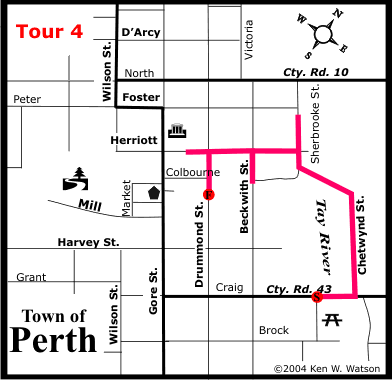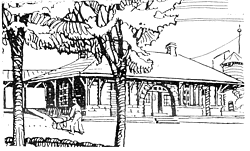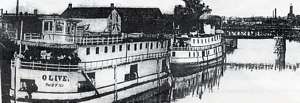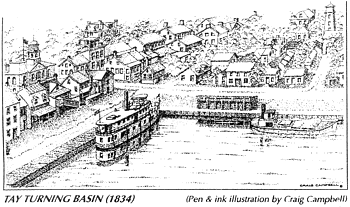(print this out and take it with you on your next visit to Perth)
Perth Tour 1 Perth Tour 2 Perth Tour 3 Perth Tour 4
 |
Original walking tour pamphlet designed by the Perth Local Architectural Conservation Advisory Committee |
Tour of the Old Burying Ground 1821 and the Industrial Part of Perth
The Old Burying Ground (1821-1972) is located at the Craig Street entrance to Cole Road of the Last Duel Park beside the Tay River. There is a double gate on Brock Street (with a posted list of people buried). The burial stone of Robert Lyon, who died on June 13, 1833 as a result of the last fatal duel in Canada, is found in the centre near a big maple tree. The Catholics were buried along Craig Street, the Protestants in the centre and the Presbyterians along Brock Street.
Cross the bridge at Craig Street and turn immediately left to the Tow Path along the Tay River or continue to Chetwynd Road and turn left.
In 1881 flat and boxcars were made at the CPR Car Shops located in the now empty bush area on your right, along Chetwynd Road. A small fire in 1888 was extinguished by a responsive fire department. In 1905 the CPR moved all equipment to Montreal. There were livestock sheds where the farmers brought animals to be shipped by railroad. Steam engines took on water at the water tank tower and turned at the Round House turntable. (The last train to use steam was the Perth local that made daily trips to Montreal.)
Along the bank of the Tay River where the Tow Path meets Riverside Road and Sherbrooke Street was the beginning of the textile industry. In 1911 the Perth Carpet Company received an order for 2000 yards of carpet for the Chateau Laurier in Ottawa. In 1917 it was replaced by Boyd Caldwell & Co. Ltd. to produce many 100% woollen products as well as the famous blanket and specialty tartans. In 1976 it was replaced by the Collie Mills which operated until the 1979 fire.
On the left side of Sherbrooke Street next to the corner of Herriott Street was the site of the demolished Drill Hall (1870-1905), where the Fencibles militia trained. This building was used for many town community activities, including skating in winter, band practices and dances. In 1905 H.K. Wampole & Co. built a 4-storey factory to produce a new tasteless extract preparation of cod liver and other pharmaceutical products. The factory was demolished in 1963 when the Company moved to a modem complex on Dufferin Street along #7 Highway. However in 1991 it was sold and in 1994 Rhone Poulenc of France moved (the business) to Montreal. (The 1931 one-storey, brick annex Wampole box factory is now Grant Edmonds' Enterprises Ltd. Printing.)
On the opposite corner facing Herriott Street a 2-storey building was constructed in 1912 for the Andrew Jergens Company. In 1939 an extra 3 floors were added for the expanded production of soap, skin preparations and cosmetics. In 1988 KOA Corporation of America and Japan became the new owners, but later in 1993 sold to the Perth Soap Company who manufactured private label products.
 At the end of Herriott Street stood, until demolished in 1979, the Old Train Station, built of mottled freestone from nearby Otty Lake. It was surrounded by freight sheds and there were spur railway lines that once served the factories. (In 1859 the first train of the Brockville & Ottawa Railway Co. took nearly ten hours in 40 degree weather to reach Perth from Brockville.) At the end of Herriott Street stood, until demolished in 1979, the Old Train Station, built of mottled freestone from nearby Otty Lake. It was surrounded by freight sheds and there were spur railway lines that once served the factories. (In 1859 the first train of the Brockville & Ottawa Railway Co. took nearly ten hours in 40 degree weather to reach Perth from Brockville.)
The Mammoth Cheese monument was built in 1943 to celebrate the 50th anniversary. The original 22,000 pound cheese was made in Perth for the Chicago World's Fair in 1893 and it measured 28 feet in circumference and 6 feet in height. (It is the largest Canadian concrete monument of a cheese.)
On the right side of Sherbrooke Street is the building of the 1912 Perth Shoe Company Limited. It was the only factory in Canada devoted exclusively to Goodyear welted shoes for ladies, the famous Naturalizers. It was sold to Brown Shoe Company in 1954 who later moved to new locations at Sunset Boulevard and Rogers Road. The building is presently used for storage by Central Wire Industries Ltd.
Return to the corner of Sherbrooke and Herriott and continue down Herriott Street. On the left side is the Herriott Street Business Court Complex, which was one of the warehouses of H.K. Wampole & Co. The restored heritage building now houses a number of stores, offices and apartments.
Past the Perth Soap Company on the right side of Herriott Street was the site of the prosperous factory of J. Templeton Tannery, built in 1837. In 1904 this building was purchased and converted into the James Bros. Foundry, which operated until 1968. The property was sold for the new Post Office, Customs Office and Canada Employment Office.
On the left side of Herriott at the corner of Beckwith Street was the 1899 James Bros. Arena. In 1933 a hardwood floor was installed and it became a popular roller-skating centre as well as a focus for many community activities. The building was demolished in 1964 and this space is now occupied by Seniors Apartments.
 Turn left at Beckwith Street and walk to the bridge. This is the last remaining swing bridge which was built over the Tay River. When the Tay Canal and the Turning Basin were completed in 1889 there were three swing bridges: Craig Street, Beckwith Street and Drummond Street. The fourth swing bridge was erected in 1890 on Gore Street, to allow boats to go to Haggart’s Mill. Turn left at Beckwith Street and walk to the bridge. This is the last remaining swing bridge which was built over the Tay River. When the Tay Canal and the Turning Basin were completed in 1889 there were three swing bridges: Craig Street, Beckwith Street and Drummond Street. The fourth swing bridge was erected in 1890 on Gore Street, to allow boats to go to Haggart’s Mill.
At the edge of the bridge on the left side of Riverside Drive is the Bridgemaster's House, built in 1889.
Continue down Herriott Street to the 1855 Old Fire Hall next to the Library. In 1883 a second storey and tower was added so that the firemen could hang the hose lines to dry. In the 1940's these quarters were too small for the new fire equipment. Today this heritage building is used by the Chamber of Commerce and B.I.A.
Go back to Drummond Street and the garden area of the Library next to the Little (Tay) River, which once housed the Lowes Livery Stables. They transported people and parcels, and provided rental services of carriages and wagons.
Walk towards the Drummond Street Bridge for a good view over the Turning Basin on the Tay River. Boats with cargo and passengers would come up the Tay Canal from Rideau Ferry on the Rideau Waterway.
From this viewpoint you are looking at Cockburn Island with the water of the Tay River flowing into the Turning Basin and the water of the Little Tay River joining the main river behind the bridge. Hence the need for two bridges on Gore Street.

This walking tour was designed by the Perth Local Architectural Conservation Advisory Committee (LACAC). n.d.
Digital versions created in 2004 by Ken W. Watson.
|